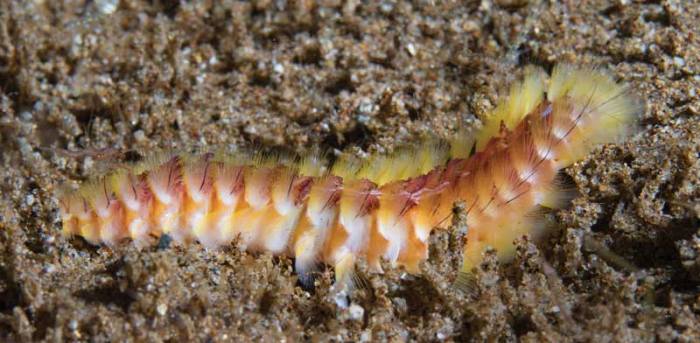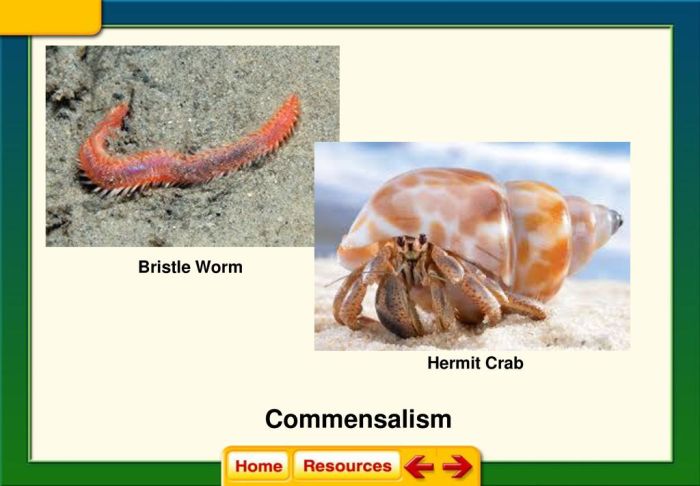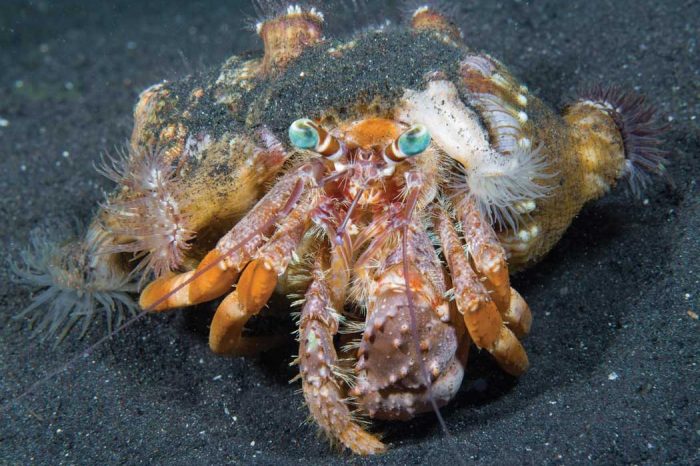Bristle worm and hermit crab – Bristle worms and hermit crabs, an unlikely duo, share a fascinating relationship that epitomizes the intricate tapestry of life on Earth. These two creatures, with their distinct appearances and behaviors, form a commensal bond that provides mutual benefits, highlighting the delicate balance of nature.
Bristle worms, with their segmented bodies and bristle-like appendages, are often found inhabiting the shells of hermit crabs. These worms feed on scraps left behind by the crab, while the crab gains protection from predators and parasites. This mutually beneficial relationship showcases the power of cooperation and interdependence in the natural world.
Bristle Worm Characteristics

Bristle worms, also known as polychaetes, are a diverse group of marine worms belonging to the class Polychaeta. These fascinating creatures exhibit a wide range of physical appearances and ecological roles.
Physically, bristle worms are typically characterized by their segmented bodies, which may vary in length from a few millimeters to several meters. Each segment bears a pair of paddle-like appendages called parapodia, which aid in locomotion and respiration. The head region often features antennae and sensory organs, while the tail end may possess specialized structures for attachment or defense.
Feeding Habits and Behaviors
Bristle worms exhibit a diverse range of feeding habits. Some species are carnivorous, preying on small invertebrates and even fish. Others are scavengers, feeding on dead or decaying organic matter. There are also filter-feeders that collect food particles from the water column using specialized structures.
Bristle worms are generally active at night, spending the day hidden in crevices or burrows. They have a well-developed sense of touch and can detect potential prey or predators through vibrations in the water.
Habitat and Distribution
Bristle worms are found in a wide range of marine habitats, from shallow coastal waters to deep-sea hydrothermal vents. They are particularly abundant in soft-sediment environments, such as mudflats and sandy beaches. Some species have adapted to live in association with other organisms, such as corals or sea urchins.
Bristle worms have a global distribution, occurring in all major oceans. They play important ecological roles as scavengers, predators, and prey for other marine animals.
Hermit Crab Characteristics

Hermit crabs are unique crustaceans known for their habit of using empty seashells as protective shelters. These fascinating creatures exhibit a wide range of physical features and behaviors that set them apart from other marine invertebrates.
Physical Features
Hermit crabs possess a distinct body structure. Their exoskeleton, which protects their bodies, consists of two main sections: the cephalothorax and the abdomen. The cephalothorax houses the head and the thorax, while the abdomen is a long, segmented structure.The head of a hermit crab features a pair of stalked eyes, a pair of antennae, and several pairs of mouthparts.
The antennae are long and slender, and they play a crucial role in the crab’s sensory perception. The mouthparts are adapted for grinding and chewing food, and they include mandibles, maxillae, and maxillipeds.The abdomen of a hermit crab is soft and vulnerable, which is why the crab seeks protection in an empty seashell.
The crab’s abdomen is coiled within the shell, and it can extend or retract its body as needed. The shell also provides the crab with camouflage, helping it to blend in with its surroundings and avoid predators.
Behavior and Social Interactions
Hermit crabs are generally solitary creatures, but they can form loose aggregations in areas with abundant food and shelter. They are omnivorous scavengers, and their diet consists of a wide variety of plant and animal matter, including algae, small invertebrates, and decaying organic material.Hermit
crabs are known for their aggressive behavior, particularly when it comes to competition for food and shelter. They will often fight with each other over desirable shells, and they may even resort to cannibalism in extreme cases.Despite their aggressive tendencies, hermit crabs can also exhibit social behaviors.
They have been observed forming long-term relationships with other crabs, and they may even share food and shelter with their partners.
Habitat and Distribution
Hermit crabs are found in a wide variety of marine habitats, including sandy beaches, rocky shores, and coral reefs. They are most common in shallow waters, but they can also be found in deeper waters.Hermit crabs are found in all oceans around the world.
They are most diverse in tropical and subtropical regions, but they can also be found in temperate and polar regions.
Bristle Worm and Hermit Crab Relationship
Bristle worms and hermit crabs share a fascinating commensal relationship, where both species benefit from their association. The bristle worm finds shelter and protection within the hermit crab’s shell, while the hermit crab gains a mobile defense mechanism against predators.
Bristle Worm Benefits
- Shelter and Protection:The hermit crab’s shell provides a secure and stable environment for the bristle worm, shielding it from predators and environmental hazards.
- Transportation:As the hermit crab moves, the bristle worm gains access to new food sources and potential mates.
- Scavenging Opportunities:The bristle worm can scavenge food scraps left behind by the hermit crab, supplementing its diet.
Hermit Crab Benefits
- Defense Mechanism:The bristle worm’s sharp bristles deter potential predators, providing the hermit crab with an additional layer of protection.
- Camouflage:The bristle worm’s long, hair-like setae can blend in with the hermit crab’s surroundings, making it less conspicuous to predators.
- Enhanced Feeding:The bristle worm’s ability to scavenge for food may supplement the hermit crab’s diet, providing additional nourishment.
Mutualism and Symbiosis

Mutualism is a type of symbiotic relationship where both organisms benefit from the interaction. Symbiosis is a broader term that encompasses all types of close relationships between different species. In the case of bristle worms and hermit crabs, the relationship is mutualistic.
The bristle worm gets a protected home, while the hermit crab gains a defense mechanism against predators.
Bristle worms and hermit crabs share a symbiotic relationship, often seen with the worm attached to the crab’s shell. Just like how these two creatures coexist harmoniously, the omega psi phi dog collar is a stylish accessory that complements any dog’s personality.
Similarly, bristle worms benefit from the protection provided by the crab’s shell, while hermit crabs enjoy the worm’s ability to clean and aerate their home.
Examples of Mutualistic Relationships
Other examples of mutualistic relationships in nature include:
Cleaner fish and host fish
Cleaner fish remove parasites and dead tissue from host fish, while host fish provide the cleaner fish with food.
Ants and acacia trees
Ants protect acacia trees from herbivores, while acacia trees provide ants with shelter and food.
Mycorrhizal fungi and plants
Mycorrhizal fungi help plants absorb water and nutrients from the soil, while plants provide the fungi with carbohydrates.
Threats to the Relationship

The commensal relationship between bristle worms and hermit crabs is not without its challenges. Several factors can disrupt or even threaten this delicate balance, potentially affecting both species.
Environmental changes, human activities, and other external factors can pose significant threats to the relationship between bristle worms and hermit crabs. Understanding these threats is crucial for conservation efforts and maintaining the health of marine ecosystems.
Environmental Changes
Environmental changes, such as climate change and pollution, can have a profound impact on the commensal relationship between bristle worms and hermit crabs. Changes in water temperature, pH levels, and oxygen availability can stress both species and disrupt their ability to coexist.
- Increased Water Temperature:Rising water temperatures due to climate change can stress hermit crabs, making them more vulnerable to predation and disease. This can lead to a decline in hermit crab populations, reducing the availability of suitable hosts for bristle worms.
- Ocean Acidification:Ocean acidification, caused by increased levels of carbon dioxide in the atmosphere, can weaken the shells of hermit crabs, making them more susceptible to damage. This can make it difficult for hermit crabs to find suitable shells, which can disrupt their relationship with bristle worms.
- Pollution:Pollutants, such as oil spills and plastic debris, can contaminate the marine environment and harm both bristle worms and hermit crabs. Pollutants can damage the respiratory and digestive systems of these animals, impairing their ability to survive and reproduce.
Human Activities, Bristle worm and hermit crab
Human activities, such as overfishing and habitat destruction, can also pose threats to the relationship between bristle worms and hermit crabs. These activities can disrupt the delicate balance of the marine ecosystem, affecting the availability of food and shelter for both species.
- Overfishing:Overfishing can reduce the availability of prey for hermit crabs, forcing them to travel further distances to find food. This can increase their exposure to predators and reduce their chances of finding suitable shells.
- Habitat Destruction:Habitat destruction, such as coastal development and dredging, can destroy the natural habitats of bristle worms and hermit crabs. This can disrupt their commensal relationship and reduce the availability of suitable hosts and food sources.
- Tourism:Unregulated tourism can disturb the natural behaviors of hermit crabs and bristle worms. Excessive handling and trampling can damage hermit crab shells and disrupt their relationship with bristle worms.
Detailed FAQs
What are bristle worms?
Bristle worms are marine worms characterized by their segmented bodies and bristle-like appendages.
What is the relationship between bristle worms and hermit crabs?
Bristle worms and hermit crabs have a commensal relationship, where the worm benefits from the crab’s protection while the crab gains from the worm’s cleaning services.
How do bristle worms benefit from living in hermit crab shells?
Bristle worms gain protection from predators and parasites by living in hermit crab shells.
How do hermit crabs benefit from the presence of bristle worms?
Hermit crabs benefit from the presence of bristle worms as they clean their shells and remove waste.